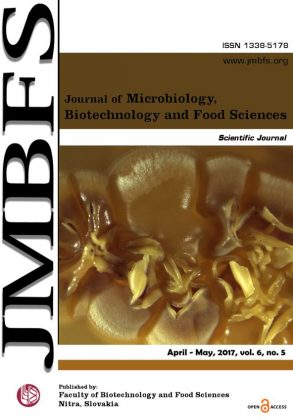GENETIC DIVERSITY ANALYSIS OF MAIZE (ZEA MAYS L.) USING SCoT MARKERS
DOI:
https://doi.org/10.15414/jmbfs.2017.6.5.1170-1173Keywords:
Dendrogram, Maize; Molecular markers, SCoT analysis, PICAbstract
Molecular characterization is frequently used by maize breeders as an alternative method for selecting more promising genotypes and reducing the cost and time needed to develop hybrid combinations. In the present investigation 20 genotypes of maize from Czechoslovakia, Hungary, Poland, Union of Soviet Socialist Republics, Slovakia and Yugoslavia were analysed using 5 Start codon targeted (SCoT) markers. These primers produced total 29 fragments across 20 maize genotypes, of which 22 (77.90 %) were polymorphic with an average of 4.40 polymorphic fragments per primer and number of amplified fragments ranged from 4 (SCoT 8) to 7 (SCoT 12 and SCoT 23). The polymorphic information content (PIC) value ranged from 0.652 (ScoT 8) to 0.816 (SCoT 23) with an average of 0.738. The dendrogram of 20 maize genotypes based on SCoT markers using UGMA algorithm was constructed. The hierarchical cluster analysis divided maize genotypes into two main clusters. Unique 2 maize genotype Slovenska žltá and Slovenska krajová velkozrná, originated from Slovak Republic, separated from others. Cluster 2 containing 18 genotypes was divided into two main subclusters. Subcluster 2a contained two Poland genotypes Przebedowska Burskynowa and Zloty Zar, two genotypes of Union of Soviet Socialist Republics- Partizanka and Krasnodarskaja and one Czechoslovakian genotypes Milada. In subcluster 2b were grouped 13 maize genotypes. The present study shows effectiveness of employing SCoT markers in analysis of maize, and would be useful for further studies in population genetics, conservation genetics and genotypes improvement.Downloads
Download data is not yet available.
Downloads
Published
2017-04-03
How to Cite
VivodÃk, M., Balážová, ŽelmÃÂra, Gálová, Z., & PetroviÄová, L. (2017). GENETIC DIVERSITY ANALYSIS OF MAIZE (ZEA MAYS L.) USING SCoT MARKERS. Journal of Microbiology, Biotechnology and Food Sciences, 6(5), 1170–1173. https://doi.org/10.15414/jmbfs.2017.6.5.1170-1173
Issue
Section
Biotechnology
License
Copyright (c) 2017 Martin VivodÃk, ŽelmÃÂra Balážová, Zdenka Gálová, Lenka PetroviÄová

This work is licensed under a Creative Commons Attribution 4.0 International License.
All papers published in the Journal of Microbiology, Biotechnology and Food Sciences are published under a CC-BY licence (CC-BY 4.0). Published materials can be shared (copy and redistribute the material in any medium or format) and adapted (remix, transform, and build upon the material for any purpose, even commercially) with specifying the author(s).





